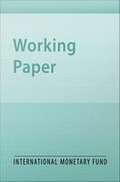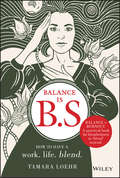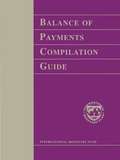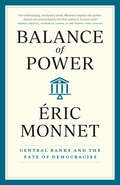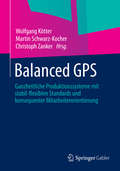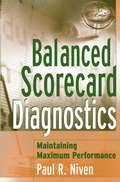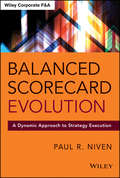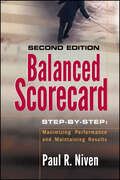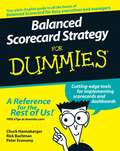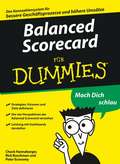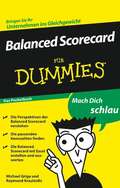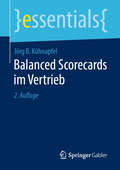- Table View
- List View
Balance Sheet
by John S. Duffield Peter J. DombrowskiEditors Duffield (political science, Georgia State U. ) and Dombrowski (Strategic Research Department, U. S. Naval War College) have enlisted the help of experts to provide a "balance sheet" on the Iraq War that evaluates the impact of the last six years on such issues as national security policy, the War on Terror, nuclear proliferation, stability in the Middle East and America's standing in the world. Written for anyone interested in the development of American foreign policy, this book analyzes the failure of counterproliferation strategies and questions whether we are safer now than before 9/11. Essays are provided by such noted writers as Steven Simon, Michael E. O'Hanlon, Clay Ramsay and Thomas G. Weiss. Stanford Security Studies is an imprint of Stanford U. Press. Annotation ©2009 Book News, Inc. , Portland, OR (booknews. com)
Balance Sheet Basics
by Spurga Ronald C.The balance sheet is the most basic tool of financial management, yet to most of today's nonfinancial managers it is a complete mystery. In Balance Sheet Basics, Ronald Spurga takes you step by step through the balance sheet to explain not only the line items and what they mean, but also how to interpret ratios derived form the balance sheet, providing an indispensable road map to good financial management. More importantly, you'll find page after page of information that will show you how to improve your 401(k), invest successfully, and increase your net worth. .
Balance Sheet Network Analysis of Too-Connected-to-Fail Risk in Global and Domestic Banking Systems
by Jorge A. Chan-LauA report from the International Monetary Fund.
Balance is B.S.: How to Have a Work. Life. Blend.
by Tamara LoehrCombine the best parts of your personal and professional life to live the life you really want Balance is B.S. is an unflinching and honest look at the challenges today’s working woman faces in balancing her professional and personal lives. In the United States, women comprise over 40% of household income. Increased gender diversity in the modern business landscape continues to have a positive impact on bottom lines and revenue reports across the economy, and offers significant benefits for ambitious women in the workplace. This increase of women in the workforce does present a serious problem—women are working longer and harder outside of the home, but their workload has not lessened inside of the home. While their career prospects rise, expectations of their family and personal lives remain flat. Women pursue the mythical “work-life” balance, and feel guilty for not reaching it. There is a better way. This insightful book provides working women with real-world advice, enabling them to blend their personal and professional lives, avoid burning out, and raise expectations of themselves and those around them. Every chapter presents practical exercises to identify values, and focus on what matters most. Following the path laid out by this essential guide, you will learn how to: Blend business and personal lives together without compromising your values Adjust expectations of yourself and others around you Use practical exercises and effective techniques to combine work, social, family, and parenting lives Stop feeling guilty about your work-life balance, and embrace the best parts of both Balance is B.S. is an invaluable resource for working women regardless of profession, experience, and status. Author Tamara Loehr draws on her years of entrepreneurial success to share her proven methods of merging work, play, and family to map out and reach the life you actually want to live.
Balance of Payments Anti-Crises
by Michael Kumhof Isabel YanA report from the International Monetary Fund.
Balance of Payments Compilation Guide
by International Monetary FundA report from the International Monetary Fund.
Balance of Payments Textbook
by International Monetary FundA report from the International Monetary Fund.
Balance of Payments and International Investment Position Manual
by International Monetary FundThe sixth edition of the Balance of Payments and International Investment Position Manual presents revised and updated standards for concepts, definitions, and classifications for international accounts statistics. These standards are used globally to compile comprehensive and comparable data and this edition is the latest in a series that the IMF began in 1948. It is the result of widespread consultation and provides elaboration and clarification requested by users. In addition, it focuses on developments such as globalization, financial market innovation, and increasing interest in balance sheet analysis.
Balance of Payments: Theory and Economic Policy
by Robert SternAn original and systematic synthesis of the major postwar developments in theory and policy of balance-of-payments adjustment, this book focuses on the present-day system of pegged-but-adjustable exchange rates and the problems that policy authorities must face if they are to attain full employment, price stability, balance-of-payments equilibrium, and a satisfactory rate of economic growth. The dominate theme of this book is that any system of exchange rates carries with it assumptions about the way it works and how effective the automatic and policy-motivated forces operate to bring about equilibrium in a country's balance of payments. By analyzing balance-of-payments adjustment and policies under alternative exchange-rate systems, and with different assumptions concerning the level of employment and prices, it is possible to embrace a wide variety of contemporary and historical circumstances experienced by individual countries and the world as a whole. In this way the author assesses the economic consequences of the different exchange-rate systems and of the policies that countries may follow to attain their national objectives. In particular it appears to Professor Stern that the international monetary turmoil of the past ten years can be traced to the exchange-rate inflexibilities of the adjustable-peg system and to the creation of excessive reserves under the dollar standard. He demonstrates that the international monetary system must be redesigned to permit greater exchange-rate inflexibility and control over the creation of new international reserve assets.
Balance of Power: Central Banks and the Fate of Democracies
by Éric MonnetCentral banks now stand between societies and collapse, but are they still democratic? Two decades of financial crises have dramatically expanded central banks’ powers. In 2008, and then again in 2020, unelected banking officials found themselves suddenly responsible for the public welfare—not just because it was necessary but based on an idea that their independence from political systems would insulate them from the whims of populism. Now, as international crises continue and the scope of monetary interventions grows in response, these bankers have become increasingly powerful. In Balance of Power, economist and historian Éric Monnet charts the rise of central banks as the nominally independent—but unavoidably political—superpowers of modern societies. This trajectory, Monnet argues, is neither inevitable nor unstoppable. By embracing the political natures of today’s central banks, we can construct systems of accountability for how they interact with states and societies. Monnet shows that this effort will do more than guard against unjust power; it will put the banks to work for greater, more democratic ends. With existential challenges looming and the work of the Federal Reserve and European Central Bank more important than ever, Balance of Power offers a trenchant case for what this century’s central banks can—and must—become.
Balance: How Justice, Equilibrium, and the Interplay of Elements Affect Consumer Thinking
by Gerald Zaltman Lindsay ZaltmanBalance is one of the deep metaphors that affects the unconscious mind-and choices-of consumers. This chapter outlines several aspects of balance that marketers should understand.
Balanced Asset Allocation: How to Profit in Any Economic Climate (Wiley Finance)
by Alex ShahidiThe conventional portfolio is prone to frequent and potentially devastating losses because it is NOT balanced to different economic outcomes. In contrast, a truly balanced portfolio can help investors reduce risk and more reliably achieve their objectives. This simple fact would surprise most investors, from beginners to professionals. Investment consultant Alex Shahidi puts his 15 years of experience advising the most sophisticated investors in the world and managing multi-billion dollar portfolios to work in this important resource for investors. You will better understand why nearly every portfolio is poorly balanced and how to view the crucial asset allocation decision from a deeper, more thoughtful perspective. The concepts presented are simple, intuitive and easy to implement for every investor. Author Alex Shahidi will walk you through the logic behind the balanced portfolio framework and provide step-by-step instructions on how to build a truly balanced portfolio. No book has ever been written that discusses asset allocation in this light. Provides insights from a top-ranked investment consultant using strategies from the industry’s brightest minds Proposes a balanced asset allocation that can achieve stable returns through various economic climates Introduces sophisticated concepts in very simple terms For those who want to better manage their investment portfolio and seek a more advanced approach to building a balanced portfolio, Balanced Asset Allocation: How to Profit in Any Economic Climate provides an in-depth treatment of the topic that can be put to use immediately.
Balanced GPS: Ganzheitliche Produktionssysteme mit stabil-flexiblen Standards und konsequenter Mitarbeiterorientierung
by Wolfgang Kötter Martin Schwarz-Kocher Christoph ZankerBei der Einführung von Ganzheitlichen Produktionssystemen (GPS) steht bislang die Standardisierung und Vereinheitlichung von Arbeitsmethoden und Arbeitsabläufen im Vordergrund. Dies zeigt sich sowohl in der betrieblichen Praxis als auch in der wissenschaftlichen Diskussion rund um GPS. Die Autoren entwickeln GPS zu einem Managementsystem weiter, mit dem zum einen die Balance von Flexibilität und Stabilität gezielt gefördert wird und zum anderen die Beschäftigten aktiv einbezogen, ihre Kompetenzen genutzt und ihre berechtigten Anliegen angemessen berücksichtigt werden. Damit wird ein völlig neuartiger Prozess zur Herstellung von arbeitspolitischer Balance im Unternehmen vorgestellt. Neben der Darstellung eines Lernprogramms für produktionsnahe Führungskräfte zur Sozial-, Kommunikations- und Konfliktkompetenz enthält das Buch auch neue Ansätze zur strategieorientierten Planung von Ganzheitlichen Produktionssystemen. Die Erkenntnisse sind anschaulich in Fallbeispielen dargestellt und vielfach um Leitlinien und Checklisten zur leichteren Umsetzung der Erkenntnisse in die Praxis ergänzt.
Balanced Paycheck
by Robert S. Kaplan David P. NortonThe final linkage from high-level strategy to day-to-day actions occurs when companies link individuals' incentive and reward programs to the Balanced Scorecard. This chapter focuses on several approaches to linking incentive compensation to Balanced Scorecards, encouraging employee understanding and acceptance of organizational strategy.
Balanced Scorecard
by Paul R. NivenThis book provides an easy-to-follow roadmap for successfully implementing the Balanced Scorecard methodology in small- and medium-sized companies. Building on the success of the first edition, the Second Edition includes new cases based on the author's experience implementing the balanced scorecard at government and nonprofit agencies. It is a must-read for any organization interested in achieving breakthrough results.
Balanced Scorecard Diagnostics
by Paul R. NivenThe complete guide to analyzing and maximizing a company's balanced scorecard Presenting the next step for balanced scorecard implementation, Balanced Scorecard Diagnostics provides a step-by-step methodology for analyzing the effectiveness of a company's balanced scorecard and the tools to reevaluate balanced scorecard measures to drive maximum performance. CEOs, CFOs, CIOs, vice presidents, department managers, and business consultants will find all the essential tools for analyzing a balanced scorecard methodology to determine if it's running at maximum performance and for seamlessly implementing changes into the scorecard. Paul R. Niven (San Marcos, CA) is President of the Senalosa Group, a consulting firm exclusively dedicated to helping businesses get best-in-class performance. He is the author of two successful books, Balanced Scorecard Step-by-Step (0-471-07872-7) and Balanced Scorecard Step-by-Step for Government and Nonprofit Agencies (0-471-42328-9), both from Wiley.
Balanced Scorecard Evolution: A Dynamic Approach to Strategy Execution (Wiley Corporate F&A)
by Paul R. NivenThe best plan is useless without effective execution The future of business has become so unpredictable that your five-year plan may be irrelevant next week. To succeed in the modern market, you must constantly assess your progress and adapt on the fly. Agility, flexibility, continual learning, and adaptation are the new rules of business success. A differentiating strategy is crucial, but it will only lead to competitive advantage if you execute it flawlessly. You'll succeed only if you have the right insight for strategic planning and the agility to execute your plan. Balanced Scorecard Evolution: A Dynamic Approach to Strategy Execution provides the latest theory and practice from strategic planning, change management, and strategy execution to ensure your business is flexible, future ready, and primed for exceptional execution. Author Paul R. Niven guides you through the new principles of The Balanced Scorecard and shows you how to apply them to your planning and strategy execution endeavors. Read case studies that illustrate the theory and practice of strategic agility and execution Learn how to create the objectives, measures, targets, and strategic initiatives that can make your plan a reality Use the latest change management techniques to boost strategy execution success Gain the knowledge and tools you need to face your challenges head-on Motivate your employees to change behaviors toward plan accommodation Making a plan isn't enough. You must actually take steps to implement your plan, and this requires excellent leadership skills. Change can be hard, and your organization may be resistant. Balanced Scorecard Evolution: A Dynamic Approach to Strategy Execution provides everything you need to make things happen.
Balanced Scorecard Step-by-Step
by Paul R. NivenPRAISE FOR Balanced Scorecard Step-By-Step: Maximizing Performance and Maintaining Results, Second Edition "As a practitioner and thought leader, Paul Niven is superbly bridging the gulf between BSC theory and application through hands-on experiences and real-world case studies. The book provides a practical road map, step-by-step, to plan, execute, and sustain a winning scorecard campaign. Easy to read . . . tells a powerful story with lessons learned/best practices from global customer implementations. Must-read for anyone interested in BSC or grappling with how to create a strategically aligned organization. " -Vik Torpunuri, President and CEO, e2e Analytix "In Balanced Scorecard Step-by-Step, Second Edition, Paul Niven provides an intuitive and incredibly effective blueprint for transitioning strategic ambition to execution. Paul's pragmatic approach provides leaders with a tool for managing a company's journey from strategic ideas to world-class performance. The Balanced Scorecard is a masterful tool for guiding companies through transformation, and I speak from personal experience when I say Paul's blueprint works! It is the most effective guide I have seen. Balanced Scorecard Step-by-Step will serve any leader well if their ambition is to efficiently engage their teams in achieving a set of strategic goals. " -Allan A. MacDonald, Vice President, Sales and Customer Solutions Bell Canada National Markets "Paul Niven has done it again!!! With this book, he has further operationalized the enlightened Balanced Scorecard concept into a fully functional system that optimizes business execution and performance!" -Barton Johnson, President, Financial Freedom Senior Funding Corporation, The Reverse Mortgage Specialist
Balanced Scorecard Strategy For Dummies
by Peter Economy Frederick Buchman Charles HannabargerA practical, easy-to-understand guide to Balanced Scorecard for busy business leadersThe Balanced Scorecard method is an analysis technique designed to translate an organization's mission and vision statement and overall business strategies into specific, quantifiable goals, and to monitor the organization's performance in achieving these goals. Much less technology driven then other analysis approaches, it analyzes an organization's overall performance in four regards: financial analysis, customer service, productivity and internal analysis, and employee growth and satisfaction. Balanced Scorecard Strategy For Dummies breaks down the basics of Balanced Scorecard in simple language with practical, Dummies-style guidance on getting it done. This book covers all the basics of Balanced Scorecard for busy executives and managers-and does it without the high price tag of most professional level Balanced Scorecard guides.
Balanced Scorecard Success: The Kaplan-Norton Collection (4 Books)
by Robert S. Kaplan David P. NortonThis collection highlights the most important ideas and concepts from Robert S. Kaplan and David P. Norton, authors of The Balanced Scorecard, a revolutionary performance measurement system that allows organizations to quantify intangible assets such as people, information, and customer relationships. Also included are Strategy Maps, which enables companies to describe the links between intangible assets and value creation with a clarity and precision never before possible; The Execution Premium, which describes a multistage system to help companies to gain measurable benefits from carefully formulated business strategy; and The Strategy-Focused Organization, which introduces a new approach to make strategy a continuous process owned not just by top management, but by everyone.
Balanced Scorecard für Dummies (Für Dummies)
by Peter Economy Frederick Buchman Charles HannabargerDie Balanced Scorecard hat sich in den letzten Jahren zu einem beliebten Führungsinstrument entwickelt. In 'Balanced Scorecard für Dummies' erklären Ihnen die Autoren zunächst die Grundlagen der Balanced Scorecard und zeigen auf, wie Sie eine Balanced Scorecard planen, einführen und umsetzen. Dann gehen Sie jeweils auf die einzelnen Perspektiven (Kundenperspektive, Finanzperspektive, interne bzw. Prozessperspektive und Wachstumsperspektive) ein. Dabei erklären sie, was Sie unter den einzelnen Perspektiven verstehen, wie Sie sie entwickeln und die daraus gewonnenen Kennzahlen auswerten.
Balanced Scorecard für Dummies (Für Dummies)
by Michael Griga Raymund KrauleidisDie Balanced Scorecard ist ein beliebtes Führungsinstrument und die richtige Anwendung ist kein Hexenwerk. Die Autoren zeigen Ihnen Schritt für Schritt, wie Sie eine Balanced Scorecard entwickeln. Zunächst geben Sie Ihnen alles Wissenswerte über Kennzahlen, die Perspektiven der Balanced Scorecard, die Unternehmensvision und -Strategie an die Hand, die die Grundlage für die Balanced Scorecard bilden. Sie erklären, wie Sie aus den Unternehmenszielen Aktionen ableiten und diesen passende Kennzahlen zuordnen. Anschließend zeigen Sie, wie Sie die Kennzahlen nach den Perspektiven der Balanced Scorecard sortieren und wie die einzelnen Kennzahlen voneinander abhängen. Erfahren Sie außerdem, wie Sie mithilfe einer Tabellenkalkulation eine übersichtliche und aussagekräftige Balanced Scorecard gestalten und diese aktuell halten.
Balanced Scorecards im Vertrieb (essentials)
by Jörg B. KühnapfelBalanced Scorecards sind zweifellos außergewöhnlich mächtige Instrumente, um Unternehmen und Funktionsbereiche wie den Vertrieb zu managen. Eine ausgeklügelte ,,Mechanik" erlaubt es Führungskräften, die strategisch relevanten Aufgaben und Ziele zu identifizieren und ständig im Auge zu behalten. Allerdings ist die Balanced Scorecard nicht trivial: Ein grundlegendes Verständnis der Wirkungszusammenhänge im eigenen Verantwortungsbereich sowie der Kennzahlensysteme ist erforderlich, um eine dauerhaft funktionierende Balanced Scorecard zu gestalten. Der Autor bietet hierfür eine Anleitung. Bei einer fachgerechten Umsetzung entsteht ein Werkzeug, das zur Grundlage der Maßnahmensteuerung in der strategischen Führung von Vertriebsbereichen werden kann. Ziele werden für jeden transparent, Entscheidungen der Vertriebsleitung nachvollziehbar und der Nutzen von Anstrengungen für jeden erkennbar.
Balanced Scorecards im Vertrieb (essentials)
by Jörg B. KühnapfelBalanced Scorecards sind zweifellos mächtige Instrumente, um Unternehmen und Funktionsbereiche wie den Vertrieb zu managen. Eine ausgeklügelte „Mechanik“ erlaubt es Führungskräften, die strategisch relevanten Aufgaben und Ziele zu identifizieren und ständig im Auge zu behalten. Allerdings ist die Balanced Scorecard nicht trivial: Ein grundlegendes Verständnis der Wirkungszusammenhänge im eigenen Verantwortungsbereich sowie der Kennzahlensysteme ist erforderlich, um eine dauerhaft funktionierende Balanced Scorecard zu gestalten. Jörg B. Kühnapfel bietet in der 2. Auflage dieses essentials hierfür eine Anleitung. Bei einer fachgerechten Umsetzung entsteht ein Werkzeug, das zur Grundlage der Maßnahmensteuerung in der strategischen Führung von Vertriebsbereichen werden kann.
Balanced and Cyclical Growth in Models of Decentralized Economy (Lecture Notes in Economics and Mathematical Systems #672)
by Alexander P. AbramovThis book is devoted to the study of dynamical models of decentralized economic systems. The models considered are based on the Leontief simple dynamic model with various mechanisms for decentralized planning and management. Branches of the economic system are treated as fully independent economic agents that plan their work according to their own purposes. It is shown that the lack of coordination between economic agents leads to a limit cycle for some economic indicators. Conversely, the exchange of information between the economic agents enables a move toward balanced growth. These results are generalized for the model with dynamics of the productive assets and for the model with the final consumption. The analysis also considers a problem of endogenous technological progress in a decentralized economy. The appendix includes a short review of non-negative matrices. The book offers a valuable resource for mathematical economists and graduate students specializing in mathematical economics.


